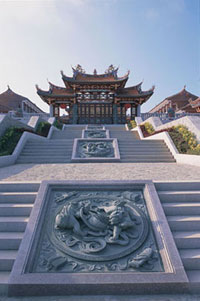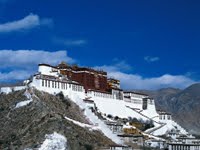Friday, December 18, 2009
Two Newham attractions have been highlighted as must-sees for tourists in London. The Thames Barrier and the Olympic 2012 site - much of which is in Newham - were named in the top 100 tourist attractions by Visit London, the official visitor organization for the capital.
Cllr Jo Corbett, Newham Council's Executive Member for Culture, said: "We are delighted that Newham has been recognized in this prestigious campaign. We are home to the Thames Barrier - one of London's most iconic structures - and yet that is just the tip of the iceberg when it comes to tourist attractions and ambitious regeneration projects in this borough."
 They include: They include:- The Royal Docks. This is fringed with striking landmarks including the Thames Barrier. The table on which the Abolition of Slavery Act was signed is in Newham's heritage collection and is currently on loan to the Docklands Museum.
- Green Street. One of Britain's most celebrated Asian shopping centers.
- Stratford is preparing to welcome over a million visitors to the 2012 Olympics. It is on the brink of a major transformation thanks to the blossoming of its cultural quarter and bold plans for Straford City.
These include a new £4bn metropolitan centre, with more than 100 shops and three big department stores.There will be a new commercial district with landmark towers and leisure facilities. New urban districts will house an extra 11,000 residents and 30,000 workers. It will also house most of the 2012 Olympic athletes.
Cllr Corbett added: "Visit London's recognition clearly shows that Newham is a go-ahead borough, a real place of progress. Stratford International station will open soon and work on Stratford City and the Olympic and Paralympic sites is under way. This regeneration is at the forefront of progressing Newham's priorities - even in today's tough economic climate."
Labels: Countries Tourism, Tourism attractions, World Tourism, World travel guide, World Vacation
Wednesday, December 16, 2009
Sunday, December 6, 2009
 Pulau Tiga is the largest of the three islands that make up Pulau Tiga Park. Its beautiful landscape and unspoilt natural environment has attracted CBS TV Network of the USA to use this island as the main location for the popular 'Survivor' Programme, dubbing it the 'Survivor Island'. This island was formed through the eruption of several mud volcanoes. The last explosion happened in 1941 and since then the volcanoes have remained relatively passive. Several small mud volcanoes spewing cool, mineral-rich mud can still be found near the summit of the island. The notion that this mineral rich mud is good for your skin makes mud-bathing a must-do activity on this island. The island's lush green jungle serves as a soothing backdrop, while the fine, white sand beaches and the clear unpolluted water are a wonder for nature lovers. The coral reefs encircling the island are home to many species of fish and other marine life. Among the activities that await you here are diving, non-motorised water sports, trekking, bird watching and mud bathing. The Park Headquarters is situated on the southern side of the island, not far from Pulau Tiga Resort, the only resort facility available on the island. Labels: Beauty Tourism, Malaysia Tourism, Tourism attractions, World Tourism, World travel guide
Monday, November 2, 2009
The seven hills of Amman are an enchanting mixture of ancient and modern. Honking horns give way to the beautiful call to prayer which echoes from the stately minarets which grace the city. Gleaming white houses, kabab stalls and cafes are interspersed with bustling markets-known in Arabic as souqs-and the remains of civilizations and ages long past. Sunset is perhaps the best time to enjoy Amman, as the white buildings of the city seem to glow in the fading warmth of the day. The greatest charm of Amman, however, is found in the hospitality of its residents. Visitors to Amman-and the rest of Jordan, for that matter-are continually surprised by the genuine warmth with which they are greeted. "Welcome in Jordan" is a phrase visitors will not soon forget.
Amman is built on seven hills, or jabals, each of which more or less defines a neighborhood. Most jabals once had a traffic circle, and although most of these have now been replaced by traffic lights, Amman’s geography is often described in reference to the eight circles which form the spine of the city. First Circle is located near downtown, and the series extends westward through Eighth Circle. Labels: Beauty Tourism, Countries Tourism, Tourism attractions, World Tourism, World travel guide
Friday, October 30, 2009
 Tibet boasts the most hot springs in China. Yambajan, world-famous for its spectacular phenomenon of hot springs boiling on the cold plateau, features all kinds of hot springs including highest-temperature hot springs, boiling springs and geysers as well as common hot springs, the area of which totals more than 7,000 square meters. The early morning in Yambajan is the most beautiful. In the cold morning, the hydrothermal fields are always suffused with white haze and the lake surface is always covered with great steam agglomerations, which is really fascinating and makes Yambajan a wonderland. If you are lucky enough, you may have a chance to witness the fantastic and splendid scene: the boiling water is erupting to the sky from the mouth of hot spring. Yambajan features eight spectacular scenic spots. The first: Bread-Steaming Hot Spring. Bread can be steamed over the hot springs near Tsangpuqu River in the southeast Yambajan. The second: Fish-Cooking River. The melted ice and snow flowing down from mountains converges to be the water of Tsangpuqu River, which, when flowing across Yambajan, is boiled by the heat erupting from the riverbed. As a result, the fish swimming here are cooked, floating on the surface of the water and becoming the food of passing-by birds and animals. The third: Noodle-Cooking Hot Spring. Around a limpid stream in the southwest Yambajan bestrew a lot of small hot springs, from the mouth of which, the boiling water with the temperature of 90 0c bubbles out and can cook noodles and eggs. The four: Alkali-Liquor-puffing Fountain. In the southwest Yambajan, a big fountain with a diameter of 1.5 meters can puff alkali liquor. The fifth: Vinegar Boiling Spring. With a diameter of 1 meter and a depth of 4 meters, the milk-white acid boiling spring is as delicious as the Shanxi Vinegar (a famous vinegar in China). The sixth: Hot Water Lake. The lake, located in the northeast basin, is as big as more than 20 basketball courts. The highest temperature of the lake middle reaches 57.7 0c. There was a folktale about the lake. It was said to be a big natural bathing pool that Jade Emperor constructed for the female court attendants in the heaven, who would bath in the lake in the evening. The seventh: Warming Ditches. At the foot of a mountain in the north Yambajan, there are four ditches covered with soft grit. Getting off the bus and sitting on the soft grit, you will find yourself sitting by the fireplace, warm and comfortable all over. The eighth: Sulphur Ditch. Location Covering an area of about 150,000 square meters, Yambajan, 87 kilometers away from Lhasa, is situated in the basin at the foot of Nyainqentanglha Mountains to the northwest of Lhasa. Labels: Beauty Tourism, Tourism attractions, World Tourism
Tuesday, October 27, 2009
 Close to the world's tallest statue of the goddess A-Ma (also known as Tian Hou), which stands on a 170-metre high peak on a mountaintop on Macau's Coloane Island, a 7,000-square meter cultural complex celebrates the beloved deity's legend. The development of the A-Ma Cultural Village was started during the Chung Yeung festival in 2001 shortly after the A-Ma Cultural and Tourism Festival of Macau. Today, construction of the Qing Dynasty-style complex is nearly finished. Surely the village, which comprises a bell tower, drum tower, carved marble altar in the Tian-Hou Palace, a dressing hall, museum and shops will attract many A-Ma devotees and interested tourists, especially those from the Mainland, Taiwan, Hong Kong and Fujian Province, where the goddess A-Ma is believed to have been born more than 1,000 years ago. Visitors approach the village by six rows of stairs carved with auspicious Chinese patterns like of the roaring tiger, the double lion, the five cranes and double phoenix that lead to the Tian Hou Palace. Plans for the future include a vegetarian restaurant and more Macanese and Taiwanese snack stalls, folk handicrafts and souvenir shops and other tourist facilities. Labels: Countries Tourism, Tourism attractions, World Tourism, World travel guide
Monday, October 19, 2009
 It boasts of the world's longest navigable underground river. This site is currently ranked number 8 on the list of New Seven Wonders of the World. The Puerto Princesa Subterranean River National Park is located about 50 km north of the city of Puerto Princesa, Palawan, Philippines. It features a limestone mountain landscape with an 8.2 km. navigable underground river. A distinguishing feature of the river is that it winds through a cave before flowing directly into the South China Sea. It includes major formations of stalactites and stalagmites, and several large chambers. The underground river is reputed to be the world's longest navigable. At the mouth of the cave, a clear lagoon is framed by ancient trees growing right to the water's edge. Monkeys, large monitor lizards, and squirrels find their niche on the beach near the cave. Labels: Puerto Princesa Subterranean River, Tourism attractions, Travel, World Tourism, World Tourist Spots
Tuesday, October 13, 2009
 This architectural wonder is Lhasa' cardinal landmark. It can be seen from all directions for miles around. Potala was set up in the seventh century AD during the reign of King Songtsen Gampo. It's located on the Red Hill, covers an area of 41 hectares.
Potala consists of the White and Red palaces with more than 1000 rooms. The white places was for secular use.
It contained living quarters, offices, the seminary and the printing house. The red Palace's function was religious. It contained gold stupas, which were the tombs of eight Dalai Lamas, the monks' assembly hall, numerous chapels and shrines, and libraries for Buddhist Scriptures.
With its world-wide reputation, the Potala stands on the Red Hill overlooking the Tibetan city of Lhasa as a major national cultural monument under special protection by the government of the People's Republic of China.
The name of the large sacred Buddhist building complex is a derivation from Samskrit Potalaka which is the mythical mountain abode of Avalokitesvara, one of the Bodhisattvas (Buddhist saints). In this connection Lhasa is popularly referred to as Second Mount Potalaka.
At an elevation of more than 3,700m, the Potala occupies an area of more than 360,000m. Its 13-story main portion rises 117m. The whole complex, consisting of halls, stupa-tomb halls (where the relics of the supreme lamas are preserved), shrines, prayer rooms, monks' dormitories and courtyards, is recognized as the world's highest and largest castle palace.
Built against the terraced slope of the hill, the structures combine to from a huge sky-scraping mass, reminscent of the divine realm above the mortal world. The granite walls elaborately decorated with soft white thatch, the golden roofs decorated with big gilded bottles, the splendid curtains and banners, join to form a unique structural wonder bearing the striking colors red, white and yellow characteristic of Tibetan architectural art, making the Potala an eminent example of a constructive technology traditionally Tibetan and Chinese. Labels: Information tourism, Tourism attractions, World Tourism, World travel tourism
|





















